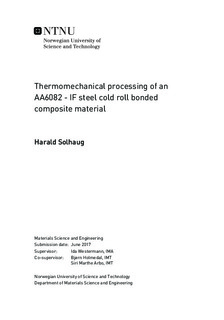Thermomechanical processing of an AA6082 - IF steel cold roll bonded composite material
Master thesis
Permanent lenke
http://hdl.handle.net/11250/2455841Utgivelsesdato
2017Metadata
Vis full innførselSamlinger
Sammendrag
The work carried out in this thesis was conducted to investigate thermomechanical aspects of a steel-aluminum cold roll bonded material. The objective was to study different production parameters related to ageing of an AA6082 aluminum alloy, combined with IF steel, through a cold roll bonding process. Three different sequences of solutionizing, ageing, and cold roll bonding of the materials were tested.
Sheets of steel and aluminum, measuring 30 x 120 mm, were used to produce the samples. Each sheet measured roughly 1 mm in thickness, and were stacked together to form a three layered composite, with aluminum in the middle and steel on either side. The sheets were prepared by scratch brushing, and were roll bonded at pre-heat temperatures of 150, 200, \& 300 $^o$C. Three different sequences were used for heat treating the aluminum; The BSA samples were roll bonded, followed by solutionizing and ageing to T6. The SBA samples were solutionized, roll bonded, and then aged to T6. The SAB samples were solutionized and aged to T6, followed by roll bonding. The three sequences were meant to determine the optimal way of producing a precipitation hardened structure in the aluminum, while still achieving a good bond to the steel.
The cold roll bonded samples were cut into sections and studied through several microstructural and mechanical characterization methods. Optical and scanning electron microscopes were used to study the aluminum grain structure, and the roll bonded interface. A peel testing rig was designed and built to allow for peel testing of the composites with at 90 degree peeling direction. Energy-dispersive X-ray spectroscopy was used to study the resulting fracture surfaces, to determine the amount of residual material left on each surface.
In summary, the SAB samples were found to produce the greatest bond strengths, followed by the SBA samples, and the BSA samples. The achieved bond strength values were overall fairly low compared to what others have achieved. The solutionizing step caused the aluminum in all samples to recrystallize, and the BSA samples, which were solutionized after roll bonding, developed an intermetallic layer roughly 1 $\mu$m thick. This layer was found to severely impact the bond strength of the composite. No intermetallic layers were found for the two other sample sequences. Roll bonding after solutionizing was not found to have any negative effects on the ageing potential. The bonding mechanism was found to be consistent with the film theory.
